When responding to a call, every first responder wants accurate situational awareness data. And the fact is, there is a lot of it ― coming from radios, scanners, body cams,
mobile data computers, peripherals and more.
In this blog post, we’ll explore how 5G public safety technology delivers the reliable, secure, and cost-effective communications solution that emergency response teams need.
Read on to learn how the 5G network infrastructure is advancing, along with the development of purpose-built mission critical communications systems that help consolidate and manage all of those disparate devices and their data ― all at costs that support the limited budgets of public safety organizations.
Understanding the Impact of 5G on Public Safety
Emergencies are often chaotic and can escalate quickly. Consider this scenario: Many emergency agencies are responding to an earthquake in a metropolitan city. Local communication lines are down. There are fires and flooding from broken water mains trapping people amid the rubble. Thanks to 5G, emergency responders can now collaborate across agencies on the dedicated public safety network. A mobile command vehicle with 5G ensures fast, reliable communications. Responders receive live streamed drone footage to surveil the unstable area.
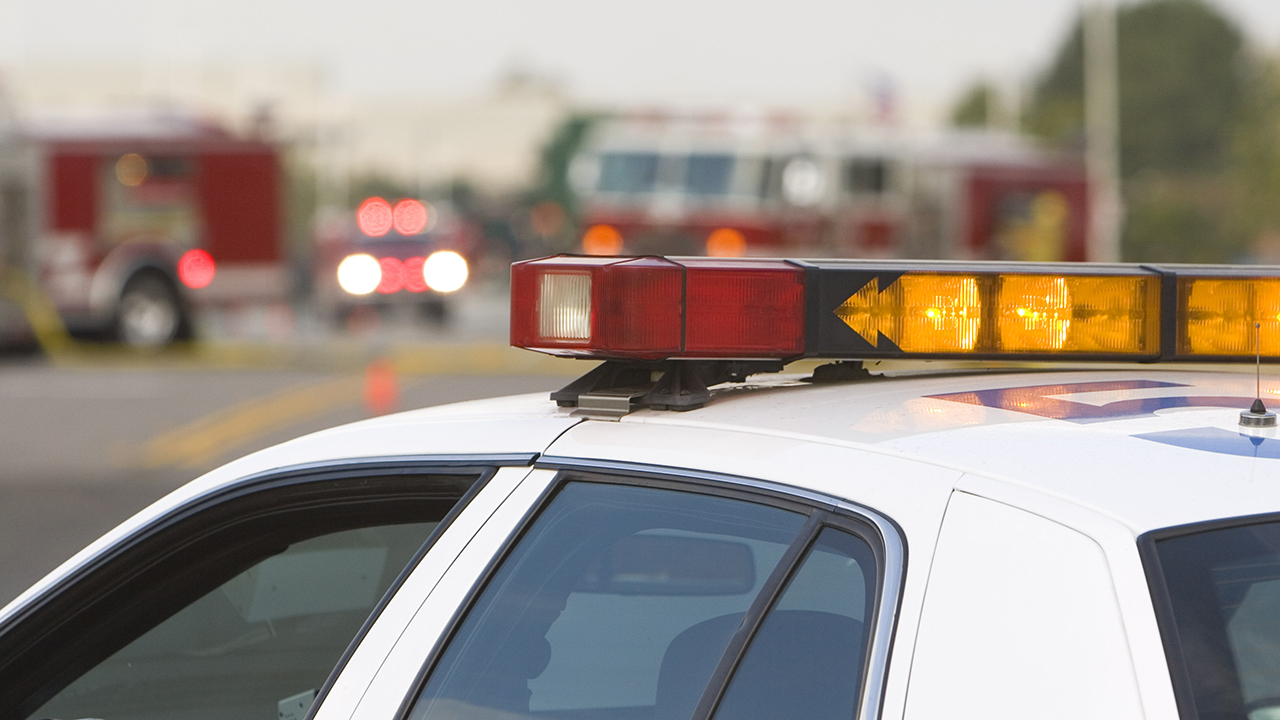
At the same time, officers respond to rescue requests while also coordinating with hospitals, precincts, ambulances and fire-fighting teams. Thanks to the low latency and ultra-reliable network and fast speeds provided by the 5G network, data volume and bandwidth constraints are no longer an issue. Emergency responders receive all the situational awareness they need. They connect with coordinating agencies and do their jobs while keeping themselves safe in a dangerous situation.
This scenario is fictional, but similar ones play out daily. Expanding 5G networks allow public safety teams to use data-intensive applications for better situational awareness when there is no room for failure.
5 Key Qualities of 5G Public Safety Networks
Over the past several years, there has been lots of hype around public safety and 5G. The promise of Gigabit speeds from mmWave is exciting, but the expansion of the C-band makes 5G practical for many public safety networks. According to IDC, 34 percent of state and local agency survey respondents are implementing 5G or are planning to in the next 18 months. Twenty five percent of the survey respondents cited the biggest benefit of 5G deployments is the ability to handle data-intensive applications.
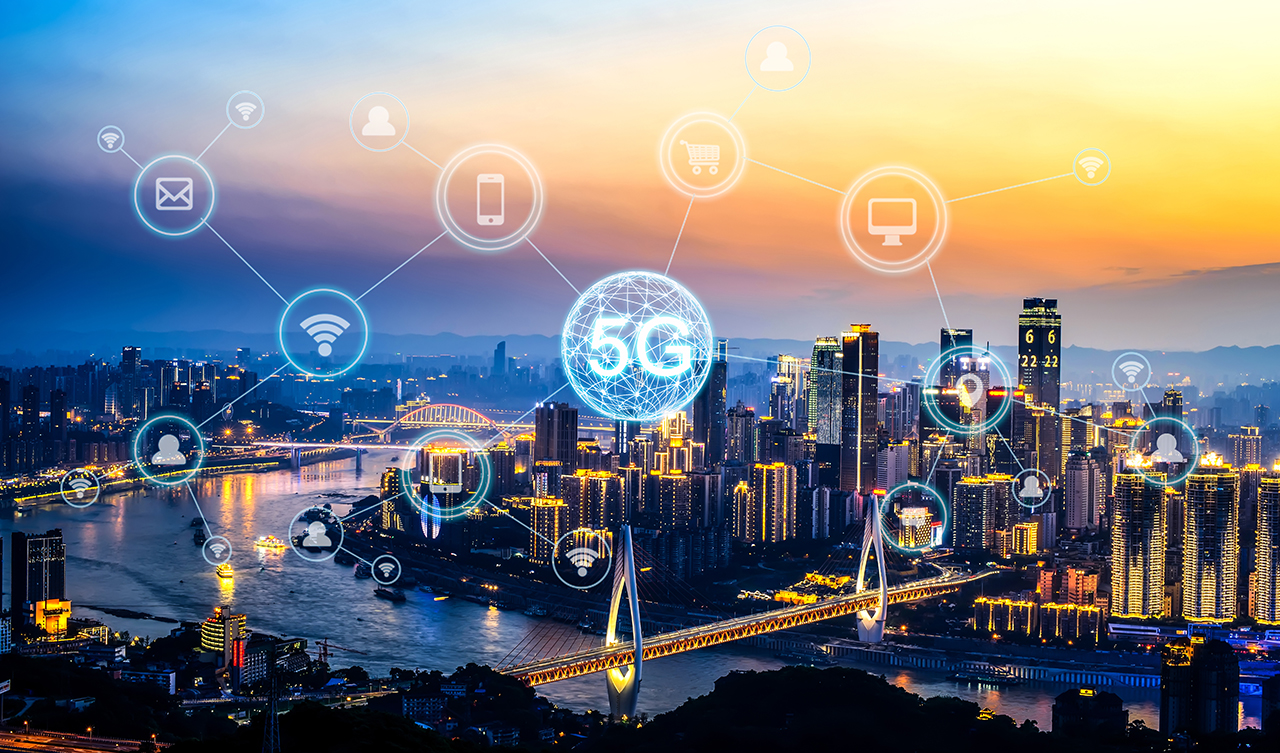
Here are 5 key qualities of 5G public safety networks.
- Faster speed — 5G is designed to manage bigger data volumes and bandwidth required by public safety teams.
- Lower latency — 5G dramatically reduces delay in communications – an important public safety consideration when quick responses are not optional.
- More secure — 5G network architecture provides better security compared to today's 4G LTE networks.
- Ultra-reliable — 5G can improve reliability through dual connectivity and coordinated multi-point 5G infrastructure coordination.
- Higher density — 5G can support many more devices in an area.
Faster Speed
Data transmission speeds for 5G are much higher compared to 4G LTE. While a typical 4G LTE network can deliver speeds of up to 100 Mbps, 5G is designed to deliver 1 Gbps or more in densely populated areas. Fast 5G networks allow emergency responders to be more informed and efficient.
More Secure
5G networks are more secure than previous cellular network generations, due to the combination of stronger encryption, segmentation through network slicing, and enhanced authentication. Built-in security features, based on machine learning and artificial intelligence, help to identify abnormal traffic patterns that could indicate a security threat and take appropriate action.
Lower Latency
Emergency responders today rely on public safety 5G networks for mission-critical communications. When responding to fast changing situations, they expect real time communications. Making life-saving decisions requires the lowest possible latency and an always-on connection.
Ultra-Reliable
A reliable network could mean the difference between life and death. That’s why public safety agencies that include police forces, fire squads and emergency medical services are converting to more reliable 5G communications networks for public safety applications.
Higher Density
5G achieves higher density through the combination of more small cells, massive MIMO, targeted beamforming, dynamic spectrum sharing, and network slicing. This enables 5G to achieve high density and support a large number of devices simultaneously. For example, 911 callers will be able to send live video through 911, and a 911 operator could access nearby security camera footage and other devices to quickly get a caller’s location or even a caller’s building floor plans. 5G is an essential part of smart city public safety infrastructure.
Learn about Digi’s complete connectivity solution for public safety networks
5G Public Safety Applications for First Responders
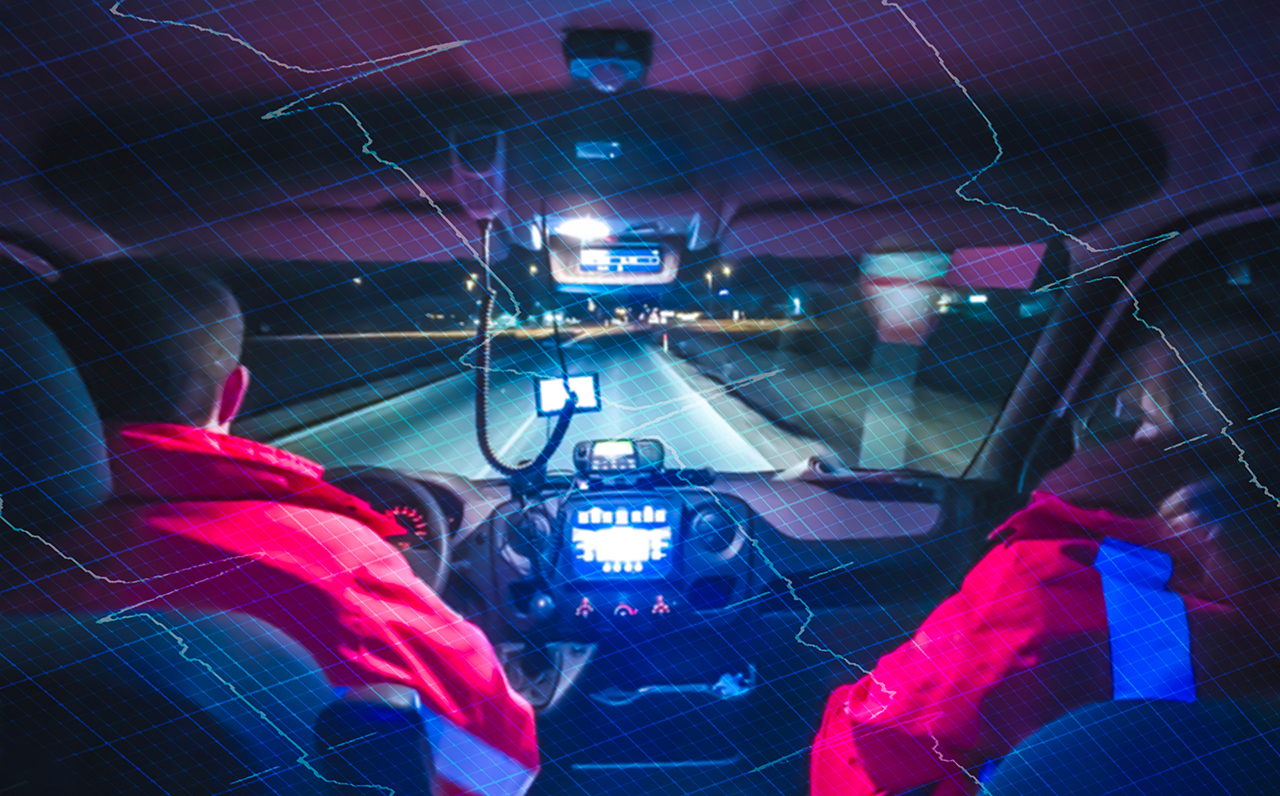
Not all emergency incidents happen in areas with fast wireless connections. With the foundational low-band, including FirstNet B14 and T-Mobile B71, and expansion of the 5G C-band, emergency communications can leap forward across more areas of the U.S. 5G for first responders has become the new standard for reliable, real-time communications, which leads to improved response times for emergency response teams.
5G Public Safety Use Cases
Public safety use cases of course span police, fire, ambulance, EMTs, mobile command units and more. Beyond the agencies and personnel, there are interesting use cases to explore where enhanced and emerging technologies can make breakthroughs in capabilities and responsiveness.
- Improve firefighting response — Real-time communications enables commanders to see what the firefighters are seeing to improve the response.
- Improve IoT device integration — First responders can now leverage smartphones, smartwatches, and other IoT public safety wearables to communicate with people in danger.
- Expand robotic, drone and camera surveillance — Improved situational awareness through high-resolution traffic camera or drone video, combined with improved location detection accuracy can significantly enhance search and rescue missions.
- Enable advanced squad car applications — A 5G-equipped squad car becomes a sophisticated command center when officers can receive real-time data enroute to a call.
- Incorporate AI — Artificial intelligence public safety applications on 5G networks drive innovation and intelligent decision-making in the field.
Agencies today are working to upgrade their infrastructure to ensure they can harness these capabilities. Let's look at some additional important use cases where advanced technology can improve the safety and effectiveness of first responders.
Increased Situational Awareness
With 5G, emergency responders can take advantage of drones and other connected devices to improve situational awareness. A survey conducted by Motorola shows that citizens support advanced technologies for public safety applications. According to the survey, 88 percent of citizens globally support public safety technology transformation. Seventy-one of the respondents think video cameras, data analysis, cybersecurity and cloud computing are necessary to meet modern challenges.
Reduced Response Times
Integrating cellular 5G for public safety into next-generation 911 services can enable faster response times. Today, 80 percent of 911 calls come from a mobile devices, so emergency call centers need to use compatible technology. The FCC has officially proposed new rules for wireless carriers on 4G LTE and 5G networks. The new rules require 911 call centers to route calls based on the caller's location instead of the location of the nearest cell tower. This helps solve the misrouting of 911 calls to the wrong call centers miles out of the way. There is a huge opportunity. According to the FCC, we could save over 10,000 lives annually if public safety responders reached callers just one minute faster.
Connectivity in Large-Scale Emergencies
In large-scale emergencies where local communications lines are out, mobile command vehicles may provide primary communications for the first responders. Because communication is the primary purpose of mobile command vehicles, they serve as remote command centers during emergency events.
From fighting wildfires or rescue operations after an earthquake, these vehicles quickly create secure, robust communication networks for first responders. These vehicles must stay connected 24x7, which makes adding 5G networking an obvious choice. 5G networks increase bandwidth and reduce latency. In mobile command vehicles, this leads to improved situational awareness. For example, 5G networks enable a mobile command center to send and receive streaming high-definition video, control and communicate with drones and even share very large data files such as weather maps.
Equipping a Mobile Command Vehicle for Large-Scale Emergencies
Reliable communications are mission critical for any incident response — wherever your teams may need to go. And it's equally true of remote and mobile response teams that handle on-site emergencies such as remote wildfire management and the aftermath of severe weather incidents. These vehicles must be equipped with cellular, Wi-Fi and satellite to ensure reliable connectivity to computers, radios and peripherals.
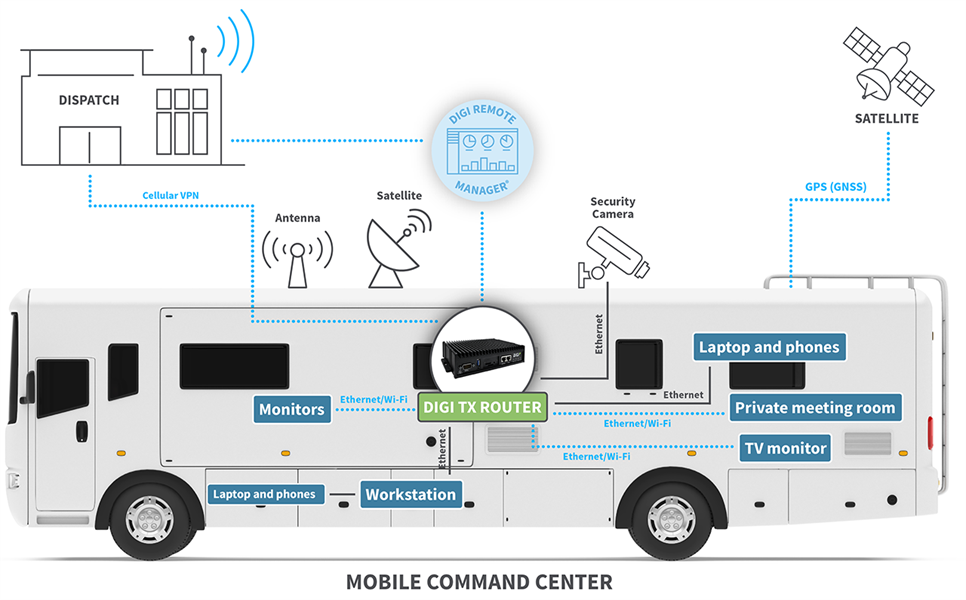
Enhanced Collaboration Among Public Safety Agencies
A 2021 survey shows that 93% of people believe coordination between agencies is critical when responding to a crisis. Yet, if police, EMS, and firefighters want to talk to each other at the scene of an emergency, they must carry several walkie-talkies. The focus on public safety and 5G cities means agencies are starting to embrace reliable, secure and dedicated public safety networks.
Transforming Public Safety Networks from LTE to 5G
We have covered some public safety trends and key reasons for transforming public safety networks from LTE to 5G. We’ve explored several 5G use cases for public safety. Whether enabling cross-agency collaboration or improving situational awareness, 5G for first responders improves safety and saves lives. Digi designs purpose-built end-to-end smart public safety solutions to fit any application and budget. As you plan your transition from LTE to 5G, don’t forget to include your public safety information technology partner. Digi has network management tools that create incredible efficiencies for busy IT teams.
Key Considerations for Transitioning from LTE to 5G
Technology upgrades require a thoughtful approach, with an eye toward the timeline of the project, the cost of upgrading existing technology infrastructure, and the expected return on investment. All of these can be impacted if you don't have the time and resources on your staff to plan and complete the project on-time and on-budget. We have some key recommendations:
- Select an implementation partner you can trust. Since 1985, Digi has been a pioneer in machine-to-machine communication and today is an industry leader in wireless communications for the IoT. We will help you through every step of transforming your LTE network to 5G.
- Select purpose-built equipment. Digi provides complete purpose-built solutions for transportation, mobile communications and public safety.
- Don’t forget management software. Digi Remote Manager® enables your IT team to easily track, manage and update all Digi connected devices.
- Concerned about cost? Consolidation of your network infrastructure can help reduce the cost of new technology. Some municipalities may be able to obtain a cellular 5G for public safety grant to support the technology upgrade.
Meet Digi's 5G Public Safety Solutions and Support
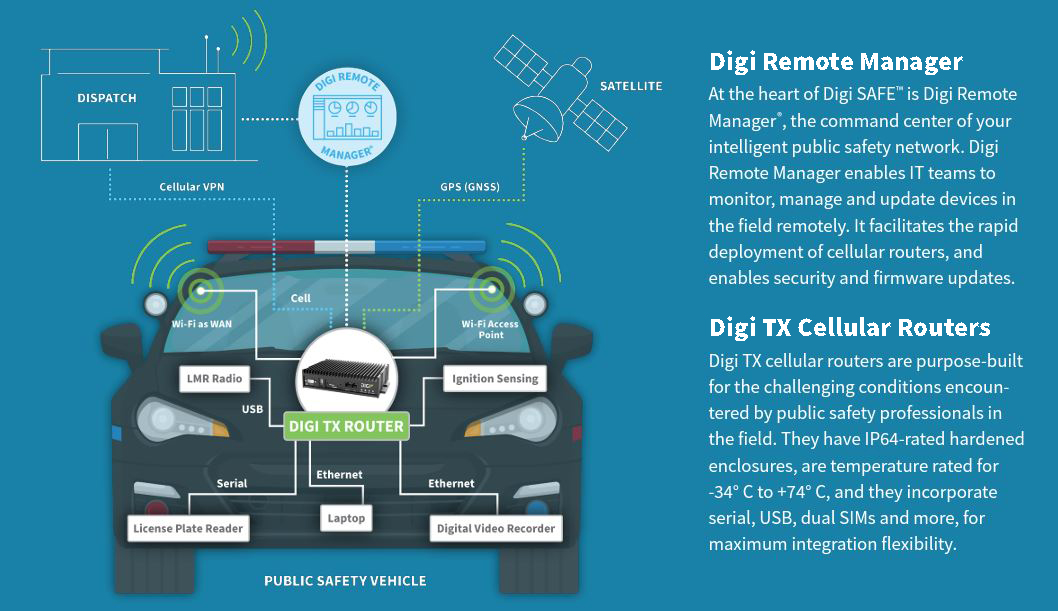
Digi solutions are reliable, powerful, purpose-built for transportation, rugged use cases and emergency response - and they go wherever your force needs to go. And we have the supporting engineering services to help your roll out your project rapidly.
- Digi SAFE™ — Digi’s complete end-to-end connectivity solution purpose-built for emergency responder vehicles
- Digi TX 5G/LTE routers — We designed these rugged transportation routers for extreme conditions and include dual SIMs for persistent connectivity
- Digi TX40 5G cellular router — The Digi TX40 transportation router is a 5G wireless communications hub to connect all devices through a fast and reliable vehicle area network
- Digi EX50 5G cellular router — Our cost-effective enterprise routers make great choices for environmentally controlled mobile command units
- Digi Professional Services — Our engineering team can help you select, configure and install equipment appropriate for your purpose
Learn More About Digi SAFE
If your team is seeking next-generation communications technology, with ultra fast 5G, better throughput and reliability — and lower cost — then it's time to evaluate Digi SAFE, Digi's complete connectivity solution for public safety and emergency services mobile networks.
Fast. Secure. Reliable. 5G impact on public safety is transformational. By dramatically improving situational awareness and enabling interagency collaboration, officers can respond faster and stay safer. Digi understands the special challenges emergency responders face. That’s why we continue to grow and enhance our line of solutions for police, fire, and EMS departments of all sizes. The Digi TX line of routers apply specifically to transportation applications and include the latest-generation GNSS dead reckoning technology for more accurate location information than is possible with standard GPS. We offer cost-effective solutions that work great for smaller agencies, too.
Take the next step now to start transitioning your LTE to 5G with Digi.
Next Steps